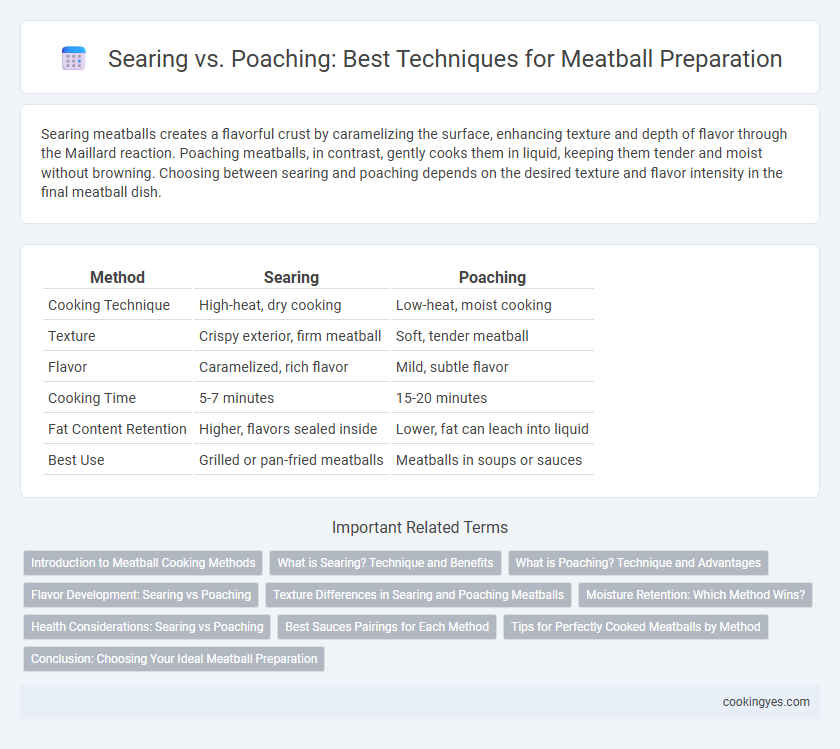Searing meatballs creates a flavorful crust by caramelizing the surface, enhancing texture and depth of flavor through the Maillard reaction. Poaching meatballs, in contrast, gently cooks them in liquid, keeping them tender and moist without browning. Choosing between searing and poaching depends on the desired texture and flavor intensity in the final meatball dish.
Table of Comparison
| Method | Searing | Poaching |
|---|---|---|
| Cooking Technique | High-heat, dry cooking | Low-heat, moist cooking |
| Texture | Crispy exterior, firm meatball | Soft, tender meatball |
| Flavor | Caramelized, rich flavor | Mild, subtle flavor |
| Cooking Time | 5-7 minutes | 15-20 minutes |
| Fat Content Retention | Higher, flavors sealed inside | Lower, fat can leach into liquid |
| Best Use | Grilled or pan-fried meatballs | Meatballs in soups or sauces |
Introduction to Meatball Cooking Methods
Searing meatballs creates a flavorful brown crust through the Maillard reaction, enhancing texture and depth of taste, while poaching cooks meatballs gently in liquid, preserving moisture and tenderness. Searing is ideal for achieving a robust outer layer before finishing in sauce, whereas poaching ensures even cooking and a soft interior. Choosing between these methods depends on desired texture and flavor profile in meatball preparation.
What is Searing? Technique and Benefits
Searing is a high-heat cooking technique that browns the surface of meatballs, creating a flavorful crust through the Maillard reaction. This method enhances texture and intensifies savory flavors while locking in juices, resulting in moist and tender meatballs. Searing also speeds up cooking time compared to gentler methods like poaching, making it a preferred choice for achieving depth of flavor and appealing appearance.
What is Poaching? Technique and Advantages
Poaching is a gentle cooking technique where meatballs are submerged in simmering liquid at a low temperature, typically between 160-180degF (71-82degC), allowing even cooking without browning. This method helps retain moisture and tenderness, producing juicy meatballs with a delicate texture. Poaching also reduces the risk of overcooking and preserves the natural flavors, making it ideal for leaner meatball recipes or those requiring a light, moist finish.
Flavor Development: Searing vs Poaching
Searing meatballs creates a Maillard reaction that develops a rich, caramelized crust, intensifying the flavor and adding depth to the overall dish. Poaching, on the other hand, cooks meatballs gently in liquid, preserving tenderness but resulting in a milder flavor without the complex notes produced by searing. Choosing searing enhances savory, browned flavors, while poaching prioritizes juiciness and subtle taste.
Texture Differences in Searing and Poaching Meatballs
Searing meatballs creates a crispy, caramelized exterior that enhances flavor through the Maillard reaction, resulting in a firmer texture contrast to the tender interior. Poaching meatballs in liquid yields a uniformly moist and softer texture, allowing the meat to remain delicate but lacking the browned crust of searing. Choosing between searing and poaching directly impacts the final mouthfeel, with searing emphasizing textural complexity and poaching prioritizing tenderness.
Moisture Retention: Which Method Wins?
Searing meatballs creates a browned crust that helps lock in juices, enhancing moisture retention during cooking. Poaching gently cooks meatballs in liquid, preserving tenderness but may cause some moisture loss if overcooked. For optimal moisture retention, combining searing to seal in juices followed by poaching ensures a juicy and flavorful meatball.
Health Considerations: Searing vs Poaching
Searing meatballs creates a browned crust that enhances flavor but can produce harmful compounds like heterocyclic amines (HCAs) and polycyclic aromatic hydrocarbons (PAHs), potentially impacting health. Poaching meatballs in water or broth minimizes the formation of these compounds, making it a healthier cooking method by reducing exposure to carcinogens. Choosing poaching helps retain moisture and nutrients without adding extra fat, aligning with health-conscious dietary practices.
Best Sauces Pairings for Each Method
Searing meatballs enhances their robust, caramelized flavor, making them ideal for pairing with rich tomato-based sauces or spicy arrabbiata, which complement the crispy exterior and savory depth. Poached meatballs, with their tender and delicate texture, pair best with lighter sauces such as a classic marinara or a creamy Alfredo, allowing the subtle meat flavor to shine through. Choosing the right sauce for each cooking method elevates the overall taste experience, balancing texture and flavor profiles perfectly.
Tips for Perfectly Cooked Meatballs by Method
Searing meatballs creates a flavorful, caramelized crust by cooking them over high heat, sealing in juices and enhancing texture, while poaching ensures gentle, even cooking by simmering meatballs in broth or sauce, preserving moisture and tenderness. For searing, use a hot pan with oil, avoid overcrowding, and finish cooking in the oven to maintain juiciness without burning. When poaching, keep the liquid at a gentle simmer, avoid boiling, and cook until meatballs reach an internal temperature of 160degF (71degC) for perfectly cooked, tender results.
Conclusion: Choosing Your Ideal Meatball Preparation
Searing meatballs creates a caramelized crust that enhances flavor and texture, while poaching ensures a tender, moist interior with gentle cooking. Selecting between searing and poaching depends on the desired balance between a crisp exterior and a soft center, with searing favored for robust, savory dishes and poaching preferred for delicate, evenly cooked meatballs. Optimal meatball preparation aligns with the sauce pairing and presentation style, influencing the final dining experience.
Searing vs Poaching for meatball preparation Infographic

 cookingyes.com
cookingyes.com